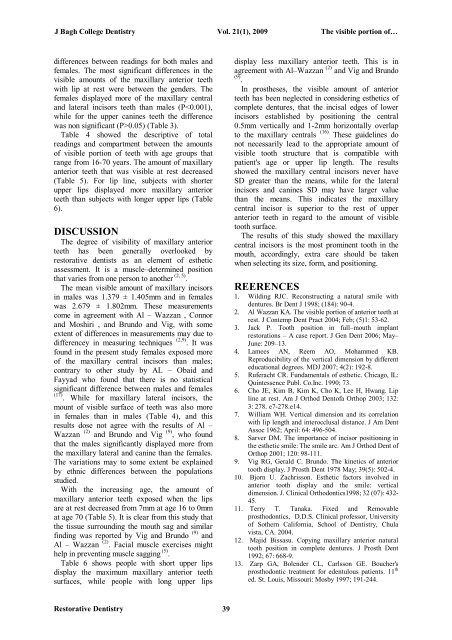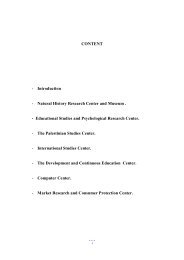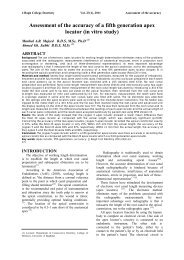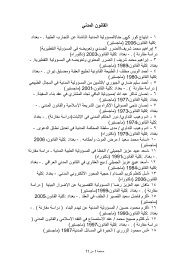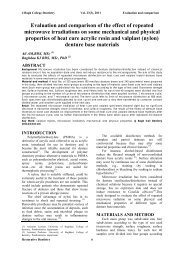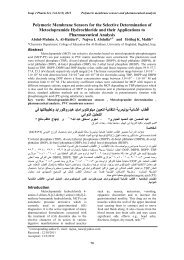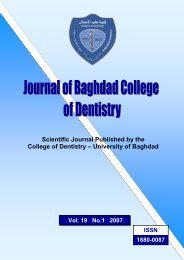Vol 21 No. 1
Vol 21 No. 1
Vol 21 No. 1
You also want an ePaper? Increase the reach of your titles
YUMPU automatically turns print PDFs into web optimized ePapers that Google loves.
J Bagh College Dentistry <strong>Vol</strong>. <strong>21</strong>(1), 2009 The visible portion of…<br />
differences between readings for both males and<br />
females. The most significant differences in the<br />
visible amounts of the maxillary anterior teeth<br />
with lip at rest were between the genders. The<br />
females displayed more of the maxillary central<br />
and lateral incisors teeth than males (P0.05) (Table 3).<br />
Table 4 showed the descriptive of total<br />
readings and compartment between the amounts<br />
of visible portion of teeth with age groups that<br />
range from 16-70 years. The amount of maxillary<br />
anterior teeth that was visible at rest decreased<br />
(Table 5). For lip line, subjects with shorter<br />
upper lips displayed more maxillary anterior<br />
teeth than subjects with longer upper lips (Table<br />
6).<br />
DISCUSSION<br />
The degree of visibility of maxillary anterior<br />
teeth has been generally overlooked by<br />
restorative dentists as an element of esthetic<br />
assessment. It is a muscle–determined position<br />
that varies from one person to another (2, 5) .<br />
The mean visible amount of maxillary incisors<br />
in males was 1.379 ± 1.405mm and in females<br />
was 2.679 ± 1.802mm. These measurements<br />
come in agreement with Al – Wazzan , Connor<br />
and Moshiri , and Brundo and Vig, with some<br />
extent of differences in measurements may due to<br />
differencey in measuring techniques (2,9) . It was<br />
found in the present study females exposed more<br />
of the maxillary central incisors than males;<br />
contrary to other study by AL – Obaid and<br />
Fayyad who found that there is no statistical<br />
significant difference between males and females<br />
(17) . While for maxillary lateral incisors, the<br />
mount of visible surface of teeth was also more<br />
in females than in males (Table 4), and this<br />
results dose not agree with the results of Al –<br />
Wazzan (2) and Brundo and Vig (9) , who found<br />
that the males significantly displayed more from<br />
the maxillary lateral and canine than the females.<br />
The variations may to some extent be explained<br />
by ethnic differences between the populations<br />
studied.<br />
With the increasing age, the amount of<br />
maxillary anterior teeth exposed when the lips<br />
are at rest decreased from 7mm at age 16 to 0mm<br />
at age 70 (Table 5). It is clear from this study that<br />
the tissue surrounding the mouth sag and similar<br />
finding was reported by Vig and Brundo (9) and<br />
Al – Wazzan (2) . Facial muscle exercises might<br />
help in preventing muscle sagging (5) .<br />
Table 6 shows people with short upper lips<br />
display the maximum maxillary anterior teeth<br />
surfaces, while people with long upper lips<br />
display less maxillary anterior teeth. This is in<br />
agreement with Al–Wazzan (2) and Vig and Brundo<br />
(9) .<br />
In prostheses, the visible amount of anterior<br />
teeth has been neglected in considering esthetics of<br />
complete dentures, that the incisal edges of lower<br />
incisors established by positioning the central<br />
0.5mm vertically and 1-2mm horizontally overlap<br />
to the maxillary centrals (16) . These guidelines do<br />
not necessarily lead to the appropriate amount of<br />
visible tooth structure that is compatible with<br />
patient's age or upper lip length. The results<br />
showed the maxillary central incisors never have<br />
SD greater than the means, while for the lateral<br />
incisors and canines SD may have larger value<br />
than the means. This indicates the maxillary<br />
central incisor is superior to the rest of upper<br />
anterior teeth in regard to the amount of visible<br />
tooth surface.<br />
The results of this study showed the maxillary<br />
central incisors is the most prominent tooth in the<br />
mouth, accordingly, extra care should be taken<br />
when selecting its size, form, and positioning.<br />
REERENCES<br />
1. Wilding RJC. Reconstructing a natural smile with<br />
dentures. Br Dent J 1998; (184): 90-4.<br />
2. Al Wazzan KA. The visible portion of anterior teeth at<br />
rest. J Contemp Dent Pract 2004; Feb; (5)1: 53-62.<br />
3. Jack P. Tooth position in full–mouth implant<br />
restorations – A case report. J Gen Dent 2006; May–<br />
June: 209–13.<br />
4. Lamees AN, Reem AO, Mohammed KB.<br />
Reproducibility of the vertical dimension by different<br />
educational degrees. MDJ 2007; 4(2): 192-8.<br />
5. Ruferacht CR. Fundamentals of esthetic. Chicago, IL:<br />
Quintessence Publ. Co.Inc. 1990; 73.<br />
6. Cho JE, Kim B, Kim K, Cho K, Lee H, Hwang. Lip<br />
line at rest. Am J Orthod Dentofa Orthop 2003; 132:<br />
3: 278. e7-278.e14.<br />
7. William WH. Vertical dimension and its correlation<br />
with lip length and interocclusal distance. J Am Dent<br />
Assoc 1962; April: 64: 496-504.<br />
8. Sarver DM. The importance of incisor positioning in<br />
the esthetic smile: The smile arc. Am J Orthod Dent of<br />
Orthop 2001; 120: 98-111.<br />
9. Vig RG, Gerald C. Brundo. The kinetics of anterior<br />
tooth display. J Prosth Dent 1978 May; 39(5): 502-4.<br />
10. Bjorn U. Zachrisson. Esthetic factors involved in<br />
anterior tooth display and the smile: vertical<br />
dimension. J. Clinical Orthodontics1998; 32 (07): 432-<br />
45.<br />
11. Terry T. Tanaka. Fixed and Removable<br />
prosthodontics, D.D.S. Clinical professor, University<br />
of Sothern California, School of Dentistry, Chula<br />
vista, CA. 2004.<br />
12. Majid Bissasu. Copying maxillary anterior natural<br />
tooth position in complete dentures. J Prosth Dent<br />
1992; 67: 668-9.<br />
13. Zarp GA, Bolender CL, Carlsson GE. Boucher's<br />
prosthodontic treatment for edentulous patients. 11 th<br />
ed. St. Louis, Missouri: Mosby 1997; 191-244.<br />
Restorative Dentistry 39


